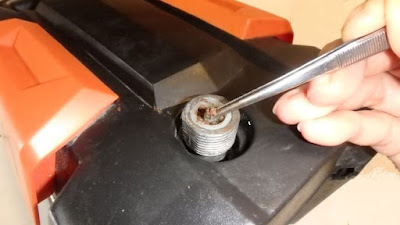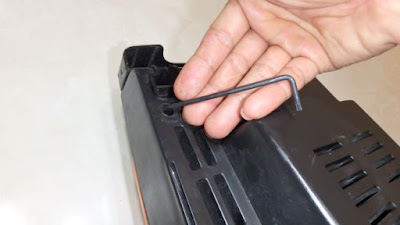Currently it is also used to spray disinfectants to prevent the spread of the corona virus or the covid 19 pandemic.
Sometime the pump is running but the water spray pressure is low and almost no water coming out. It is possible that the pump is sucking dirt and causing it to clog.
Sometime the pump is running but the water spray pressure is low and almost no water coming out. It is possible that the pump is sucking dirt and causing it to clog.
This article is about cleaning Lakoni Laguna 70 high pressure water pump is also known as high pressure washer jet cleaner. The procedure may applicable to other jet cleaner with about similar specification.
According to Lakoni Laguna 70 data, the specifications are: with an electric power of 550 watts, producing a water spray pressure of up to 100 bar or 1,450.38 psi. In comparison, car tire pressure and motorcycle tire pressure are around 30 psi. So this pump pressure is 50 times the tire pressure. Water consumption is about 5 liters per minute.
In comparison, this performance is almost the same as the Karcher K1: spray pressure of 90 bar (1,305.34 psi), water consumption of 300 liters / hour or 5 liters / minute, electric power of 850 watts.
Other brands of steam engines include: Sun Joe SPX1000, Morris, AR Blue Clean AR118, Krisbow, Firman, Bosch, Multipro, H&L, Maestro, Nankai, Raiden, Kyodo, GreenWorks 1501, Ryobi, etc..
First check the input hose connector, it should not leak or crack. Like the photo below.
According to Lakoni Laguna 70 data, the specifications are: with an electric power of 550 watts, producing a water spray pressure of up to 100 bar or 1,450.38 psi. In comparison, car tire pressure and motorcycle tire pressure are around 30 psi. So this pump pressure is 50 times the tire pressure. Water consumption is about 5 liters per minute.
In comparison, this performance is almost the same as the Karcher K1: spray pressure of 90 bar (1,305.34 psi), water consumption of 300 liters / hour or 5 liters / minute, electric power of 850 watts.
Other brands of steam engines include: Sun Joe SPX1000, Morris, AR Blue Clean AR118, Krisbow, Firman, Bosch, Multipro, H&L, Maestro, Nankai, Raiden, Kyodo, GreenWorks 1501, Ryobi, etc..
First check the input hose connector, it should not leak or crack. Like the photo below.
Clean the dirt that is in the input connector. In that connector, there is a screener. Dirt can be accumulated in the screener.
The nozzle on the spray gun can also become clogged. Clean by pricking with a safety pin or long needle. Usually the nozzle must be removed first.
If dirt escapes from the screener, it will enter the pump. And if dirt accumulates in the pump, as a result, the pump needs to be dismantled to be cleaned inside.
Before opening the pump body, first remove all pipes and hoses connected to the pump.
Before opening the pump body, first remove all pipes and hoses connected to the pump.
It needs to use a Torx wrench (star screwdriver or star bits) with size T15 and a long handle. There are 6 body screws that must be removed. Those screws are accessible from the rear body.
For 4 body screws at the top can use a long L Torx wrench ( to undo, as the above photo.
As for the 2 body screws at the bottom, the L Torx wrench is not long enough. It needs a Torx socket with a screwdriver like handle. And this Torx socket cannot be used for 4 screws on the upper body, because the diameter of the socket holder does not fit in the screw hole.
For 4 body screws at the top can use a long L Torx wrench ( to undo, as the above photo.
As for the 2 body screws at the bottom, the L Torx wrench is not long enough. It needs a Torx socket with a screwdriver like handle. And this Torx socket cannot be used for 4 screws on the upper body, because the diameter of the socket holder does not fit in the screw hole.
Then the body can be opened and it consists of 2 parts, namely the front body and the rear body. The front body has orange panels, while the rear body is completely black.
On the inside of the body, unscrew the cable latch using a Torx T15 wrench.
On the inside of the body, unscrew the cable latch using a Torx T15 wrench.
Separate the pump assembly from the plastic body. Using a Torx T25 wrench, evenly loosen 4 pump screws until they come off.
The pump body will be separated into 3 parts, namely: cylinder head, cylinder or piston housing (pump), motor include pump drive transmission.
The pump body will be separated into 3 parts, namely: cylinder head, cylinder or piston housing (pump), motor include pump drive transmission.
Remove the cylinder head from the piston housing, carefully prying it with a flat head screwdriver, at the corners near the screw holes.
The cylinder head can be brushed and washable with soapy water. In the photo below, the cylinder head is held by hand.
Check if there is any broken rubber seal, the seal can be replaced. A damaged rubber seal has a visible surface defects.
In the piston housing there are 3 piston pumps, with springs to pull those pistons back to starting position.
There is a pressure switch mounted to piston housing. That switch is connected by wire to the electric motor.
The pressure switch functions to turn off the electric motor if the water pressure is too high. This happens when the water valve on the spray gun is closed, or water is not being sprayed. Then the electric motor will turn on again, once the water valve is opened so that the spray gun will spray.
The input line on the piston housing is sprayed with a lubricant such as WD-40. Can also be sprayed by an air compressor. Especially in the filter or screener, here dirt usually collects. The direction of spraying should be the opposite of the direction of water flow. That is from the inside out, so that the dirt is easily released. It can also be sprayed with water, but be careful not to wet the electric motor.
The piston housing is attached to the piston pump drive transmission. This transmission has gears, bearings, and swash plates.
The swash plate is a disc that is tilted, so there is a high part of the dish, and there is a low part of the dish.
When the swash plate rotates, the higher part of the plate will press the piston to pump or discharge water.
On the other hand, the lower part of the disc releases pressure on the piston. So that the piston will return back to the starting position by spring force for suction.
In the transmission there is oil and grease. If the oil is reduced, you can add SAE40 oil up to the lip of the transmission housing or swash plate housing.
When cleaning is completed, all components are assembled back in the reverse order of dismantling.
For 4 pump body screws, they must be installed evenly. In order to make it easier, first install the 2 screws that are diagonally across.
The two screws can pull and tighten the entire pump body. Then the remaining 2 screws can be installed. The four screws must be evenly tightened diagonally, so as not to leak.













